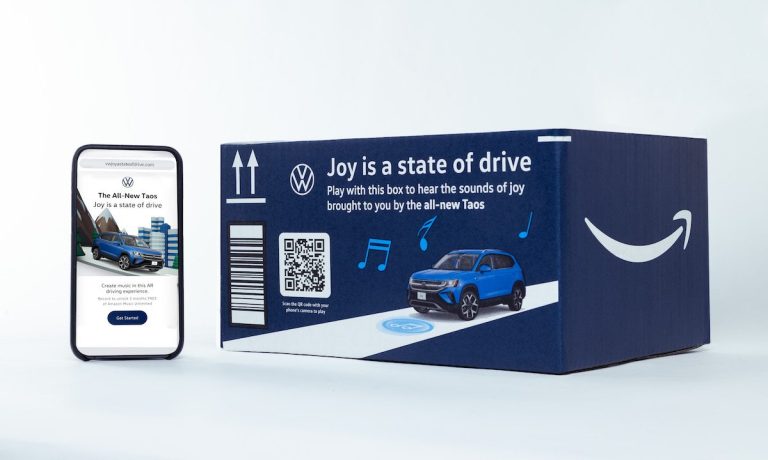
Augmented reality (AR) is being used by automakers to give potential customers a chance to explore their vehicles as if they were in a showroom and experience the car in motion as if they were on the road.
In a recent example of this, Volkswagen announced on Monday (Nov. 29) that it will be advertising a new vehicle on one million Amazon shipping boxes that will include a QR code. When scanned, it will take the user to a virtual driving experience on a 3D map. While playing the game, users can also select one of four soundtracks to add music.
“Driving and music have always been a perfect pairing,” Kimberley Gardiner, senior vice president, Volkswagen brand marketing, said in a press release announcing the campaign. “This innovative, virtual introduction to our all-new Taos gives potential music buyers a unique, music-driven way to experience another moment of joy from this SUV.”
Creating a Truly Sensory Experience
Users can record and share their drives, and by doing so they can earn a free three-month trial of Amazon Music Unlimited.
This virtual experience follows the automaker’s fall television spots for the Taos, which were created in partnership with Volkswagen of America’s creative agency, The Community.
“Our challenge was to evoke joy, creating a connection to the campaign work through a different medium,” Christopher Neff, vice president of innovation and technology at The Community, said in the press release. “We were inspired by the origins of the music box, and added the visual spectacle of WebAR plus interactive music for a truly sensory experience.”
The game uses web-based augmented reality (WebAR) technology so it can be played through the browser on a mobile device, with no need to download an app.
The AR experience is powered by 8th Wall, a development platform that enables the creation, publication and distribution of WebAR and web-based virtual reality (WebVR) content. Case studies on 8th Wall’s website and blog show how others in the automotive industry have used these tools to engage with potential customers and others.
Engaging Customers With Interactive Experiences
For Infiniti, Visionaries 777 used the platform to create animated instructions for how to fold paper into the shape of the Infiniti QX55.
For Toyota, Road & Track created an experience that allows the user to scan a QR code in a print ad and then see, through their phone, a 3D model of a Toyota Supra sitting in their garage, driveway or anywhere else. What’s more, they can change the paint color, rotate the virtual car and share a photo of the WebAR experience.
For Porsche, innovation.rocks built a WebAR-based training tool that teaches Porsche employees about the brand’s history and future. It allows users to take a seat in a digital Porsche, drive to animated Porsche locations, help build a virtual car and then take a quiz.
Airstream, the maker of travel trailers and luxury coaches, used the 8th Wall platform to create a virtual tour of the Basecamp 20X. Potential customers can spin the virtual model of the travel trailer, zoom in and see details as small as the logos embroidered on the seats, look out the trailer’s front panoramic window and watch the tables convert into sleeping areas.
“WebAR opens up new ways to connect with users by engaging them in extraordinary, interactive experiences anywhere they are — with no app required,” 8th Wall says on its website.